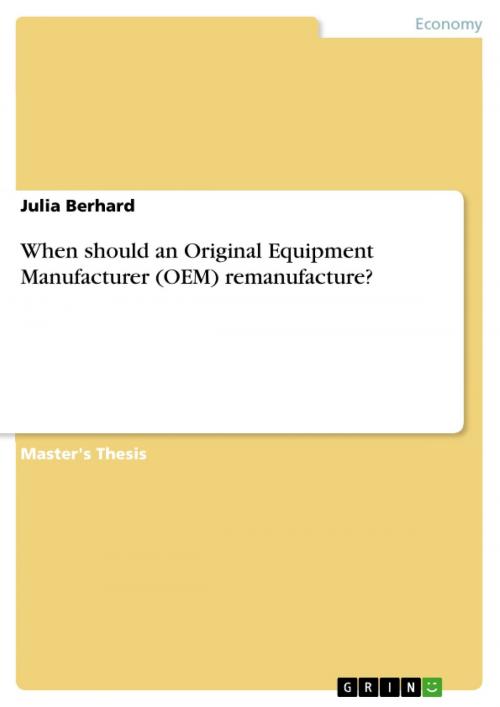When should an Original Equipment Manufacturer (OEM) remanufacture?
Business & Finance, Management & Leadership, Production & Operations Management| Author: | Julia Berhard | ISBN: | 9783668085138 |
| Publisher: | GRIN Publishing | Publication: | November 11, 2015 |
| Imprint: | GRIN Publishing | Language: | English |
| Author: | Julia Berhard |
| ISBN: | 9783668085138 |
| Publisher: | GRIN Publishing |
| Publication: | November 11, 2015 |
| Imprint: | GRIN Publishing |
| Language: | English |
Master's Thesis from the year 2015 in the subject Business economics - Supply, Production, Logistics, grade: 7,5, Erasmus University Rotterdam (Rotterdam School of Management), course: Supply Chain Management, language: English, abstract: An increasing rate of return, raw material prices and carbon emissions urge companies to look for sustainable solutions. The value of returned products can be recaptured through closed-loop supply chain activities and in particular through reconditioning, of which remanufacturing is one option that retains a high value. The definition must be clear, however, as the term is not yet common. This recovery type ensures that a restored product fulfils an equivalent or even superior function than the original product. Furthermore, it receives the same warranty as a new product and secures profits while minimizing the environmental impact. When a company decides whether remanufacturing is a viable option, several factors have to be considered. Therefore, the aim of this thesis was to provide guidance for the remanufacturing decision, while bridging the gap between research and practice. An extensive literature review provided general remanufacturing benefits and issues, as well as a selection of the most important influencing characteristics. Subsequently, hypotheses were formulated per characteristic category, which were product, internal and external, and tested via surveys and statistically. The analysis yielded that a product should be highly modular, have a long product life cycle and a residual value. The internal processes require sufficient return quantities as a starting point, low processing costs compared to the original production and the processing time has to be weighed against other benefits. In addition, a market demand has to be established and the cannibalization effect should be taken into account. Finally, a positive perception of remanufactured products and sufficient market channels to commercialize them are favourable for remanufacturing. Using the survey means of the influencing characteristics a ranking was created, irrespective of the signs, but with regard to the strength. The top five are processing costs, residual value, customer perception, product life cycle and processing time. These rankings are slightly different depending on the industry. Lastly, interviews with experts further supplemented the analysis and a managerial framework was created to provide guidance for the remanufacturing decision process. ?
Master's Thesis from the year 2015 in the subject Business economics - Supply, Production, Logistics, grade: 7,5, Erasmus University Rotterdam (Rotterdam School of Management), course: Supply Chain Management, language: English, abstract: An increasing rate of return, raw material prices and carbon emissions urge companies to look for sustainable solutions. The value of returned products can be recaptured through closed-loop supply chain activities and in particular through reconditioning, of which remanufacturing is one option that retains a high value. The definition must be clear, however, as the term is not yet common. This recovery type ensures that a restored product fulfils an equivalent or even superior function than the original product. Furthermore, it receives the same warranty as a new product and secures profits while minimizing the environmental impact. When a company decides whether remanufacturing is a viable option, several factors have to be considered. Therefore, the aim of this thesis was to provide guidance for the remanufacturing decision, while bridging the gap between research and practice. An extensive literature review provided general remanufacturing benefits and issues, as well as a selection of the most important influencing characteristics. Subsequently, hypotheses were formulated per characteristic category, which were product, internal and external, and tested via surveys and statistically. The analysis yielded that a product should be highly modular, have a long product life cycle and a residual value. The internal processes require sufficient return quantities as a starting point, low processing costs compared to the original production and the processing time has to be weighed against other benefits. In addition, a market demand has to be established and the cannibalization effect should be taken into account. Finally, a positive perception of remanufactured products and sufficient market channels to commercialize them are favourable for remanufacturing. Using the survey means of the influencing characteristics a ranking was created, irrespective of the signs, but with regard to the strength. The top five are processing costs, residual value, customer perception, product life cycle and processing time. These rankings are slightly different depending on the industry. Lastly, interviews with experts further supplemented the analysis and a managerial framework was created to provide guidance for the remanufacturing decision process. ?















